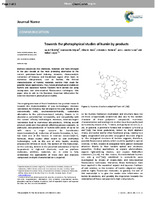Mostrar el registro sencillo del ítem
Towards the photophysical studies of humin by-products
| dc.contributor.author | Filiciotto, Layla | |
| dc.contributor.author | Miguel, Gustavo de | |
| dc.contributor.author | Balu, Alina M. | |
| dc.contributor.author | Romero, Antonio A. | |
| dc.contributor.author | Van der Waal, Jan Cornelis | |
| dc.contributor.author | Luque, Rafael | |
| dc.date.accessioned | 2019-11-07T11:18:00Z | |
| dc.date.available | 2019-11-07T11:18:00Z | |
| dc.date.issued | 2017 | |
| dc.identifier.uri | http://hdl.handle.net/10396/19064 | |
| dc.description.abstract | Biomass conversion into chemicals, materials and fuels emerged in the past decade as the most promising alternative to the current petroleum-based industry. However, the chemocatalytic conversion of biomass and bio-derived sugars often leads to numerous side-products, such as humins. The limited characterization of humin materials restricts their study for possible future applications. Thus, herein photophysical studies on humins and separated humin fractions were carried out using steady-state and time-resolved fluorescence techniques. This paper aims to add to the literature important information for scientists involved in the photophysical studies. | es_ES |
| dc.format.mimetype | application/pdf | es_ES |
| dc.language.iso | eng | es_ES |
| dc.publisher | Royal Society of Chemistry | es_ES |
| dc.rights | https://creativecommons.org/licenses/by-nc-nd/4.0/ | es_ES |
| dc.source | Chemical Communications 53, 7015-7017 (2017) | es_ES |
| dc.subject | Biomass valorization | es_ES |
| dc.subject | Side-products | es_ES |
| dc.subject | Humins | es_ES |
| dc.subject | Photophysical studies | es_ES |
| dc.title | Towards the photophysical studies of humin by-products | es_ES |
| dc.type | info:eu-repo/semantics/article | es_ES |
| dc.relation.publisherversion | https://doi.org/10.1039/C7CC03679E | es_ES |
| dc.rights.accessRights | info:eu-repo/semantics/openAccess | es_ES |

